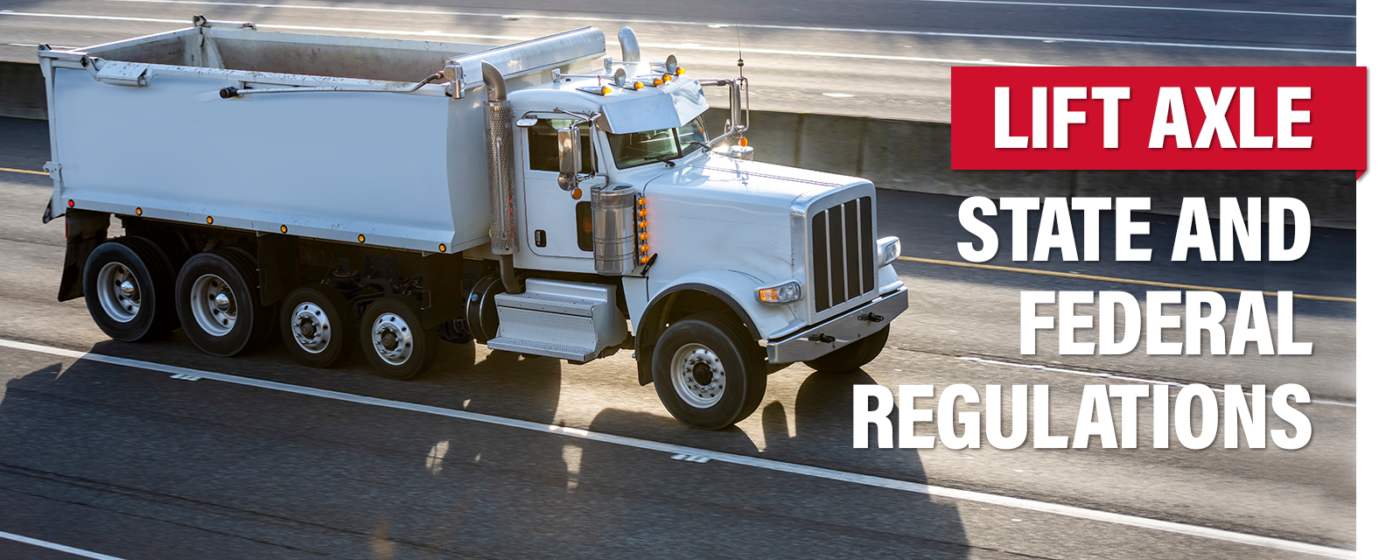
State and Federal Regulations on Lift Axles
Lift Axles are a common sight on trucks when you’re traveling on the highway. Depending on what state you’re in, a heavy-duty truck could have anywhere from one lift axle to numerous. The biggest considerations when it comes to lift axles are Federal Bridge Laws and a State’s bridge laws. Bridge laws require that a vehicle’s load must be spread out over a certain number of axles, protecting bridge spans and the road’s pavement.
Each state sets its own regulations, so when truck operators work within their home state’s boundaries, they only need consider their state’s bridge laws. However, if operators cross into multiple states, they must take into consideration the regulations of those states as well, adhering to the lowest common denominator. Federal and State bridge laws are in place to protect our roads and bridges. As a heavy haul truck driver or owner of a company, being aware of these laws and regulations is very important.
So, What Is a Lift Axle?
In short, a lift axle is an extra axle placed on the vehicle to disperse the vehicle’s total weight over a broader area. A lift axle, commonly called a pusher or tag axle, is an axle designed for heavy-duty trucks, allowing them to haul load sizes heavier than the standard axles on their vehicle and trailer could usually take.
The distinct characteristic of a lift axle is that it can be lifted off of the road’s surface when a vehicle’s load does not require the use of an extra axle. By lifting the axle, the tires are preserved and usable for a longer amount of time. Lifting the axle also prevents scrubbing in non-steerable configurations, reducing uneven tire wear and the chance of a blow-out.
The lift axle is mounted on a truck, a trailer, or sometimes both. Lift axles are typically found on tanker-style trucks, dump trucks and are used to haul over-sized loads. By increasing the number of axles on the ground, the weight of a load is spread out over a greater number of points. By increasing the number of points touching the ground, the axles have less of a burden from the weight, reducing the chance of damaging an axle by over-burdening it. The greater number of points touching the ground also decreases the weight placed on the road, reducing damage to bridges and pavement that would otherwise be caused by an increased weight caused by too few axles.
What Are Federal and State Bridge Laws?
In 1975, the United States Congress enacted the Bridge Formula to limit the weight-to-length ratio of a vehicle crossing a bridge. If a certain weight-to-length ratio is not met, a bridge can suffer damage due to the stress that the improperly distributed weight places on it. Without the regulation, bridges will suffer and break down, causing their structure to become deficient and potentially dangerous to those who cross them.
Complying with the Federal Bridge law is accomplished either by spreading the weight over additional axles or by increasing the distance between axles. By increasing the number of axles or increasing the distance between axles, the weight is distributed in a way that is less likely to damage road surfaces and bridge structures.
Bridges on the Interstate System are designed to allow transport of a wide variety of vehicles and their expected load. The bridge formula was created to determine the amount of weight spread across a certain distance and number of axles that can safely travel across a bridge The bridge formula is as follows:
W = 500 [LN/N-1 + 12N + 36]
W = The overall gross weight on any group of two or more consecutive axles to the nearest 500 pounds
L = The distance in feet between the outer axles of any group of two or more consecutive axles
N = The number of axles in the group under consideration
The Federal gross weight limit on the Interstate system is 80,000 lbs, unless the Bridge Formula dictates a lower weight limit. Additionally, Federal law dictates that single axles should be limited to 20,000 lbs and tandem axles that are spaced more than 40” but less than 96” apart are limited to 34,000 lbs.
The State bridge formula allows a gross weight of 84,000 lbs on a size-axle truck-semitrailer (TST) combination. State law provides for a 10% weight tolerance for enforcement on non-Interstate highways.
For further information about the Federal Bridge Law formula, reference FHWA’s publication.
Why Do Lift Axles Regulations Change from State to State?
There are more than 617,000 bridges across the United States. Currently, 42% of all bridges are at least 50 years old. 46,154, or 7.5%, of the nation’s bridges are considered structurally deficient, meaning they are in “poor” condition. State laws take into consideration the age and condition of the bridge when calculating each bridge’s weight limit.
Most states use weight limits similar to federal bridge weight limits. However, weight limits vary state to state, as do lift axle requirements. Some states have regulations that call for different axle configurations or operating areas for lift axles. Additionally, there are some states who offer exemptions or permits to various types of vehicles that allow them to operate above the standard Federal limits on non-Interstate highways.
You can find the correct laws regarding bridge limits, as well as truck size and weight limits by calling or checking in with the state highway department. Additionally, you can visit the US DOT’s website for the latest information on lift axle regulations.
How Can Link Help?
At Link, we are here to help you with your auxiliary axle needs and to be compliant with Federal and State bridge laws. Protecting the roads and bridges that we all depend on is a huge responsibility, one that we are happy to help you navigate.
Link Suspensions and lift axles are recognized across the industry as a premium product and solution to your heavy haul needs. Link provides steerable and non-steerable Lift Axles. Link’s steer axles include an 8K, 10K, 13.5K and 20K steerable axle. Non-steerable applications include 13.2K and 20K.
Link’s Technical Support Team, Field Sales Team, and website are here to help with axle regulations, axle spacing and the proper application for any of your auxiliary axle needs.
Blog Author
Jimmy Winslett
Senior Account Manager


